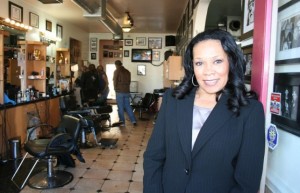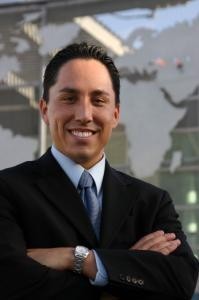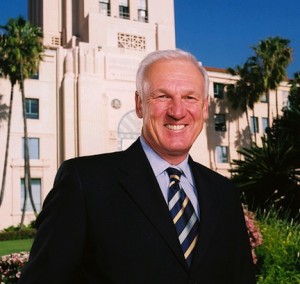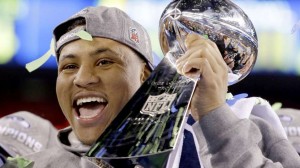 There is no better way to end Black History Month and Flashback Friday’s than with musical legend and industry influencer James Joseph Brown, Jr. (May 3, 1933 – December 25, 2006) James Brown was an American recording artist and musician. One of the founding fathers of funk music and a major figure of 20th-century popular musicand dance, he is often referred to as “The Godfather of Soul”. In a career that spanned six decades, Brown profoundly influenced the development of many different musical genres. Born in Barnwell, South Carolina, Brown moved to Augusta, Georgia, to live with relatives at the age of five. After a stint in prison for robbery, Brown began his career as a gospel singer in Toccoa, Georgia. Joining an R&B vocal group called the Avons that later evolved to become The Famous Flames, Brown served as the group’s lead singer. First coming to national public attention in the late 1950s as a member of The Flames with the ballads “Please, Please, Please” and “Try Me”, Brown built a reputation as a tireless live performer with singing group The Famous Flames and his backing band, sometimes known as the James Brown Band or the James Brown Orchestra. Brown’s success peaked in the 1960s with the live album, Live at the Apollo, and hit singles such as “Papa’s Got a Brand New Bag”, “I Got You” and “It’s a Man’s Man’s Man’s World”. During the late 1960s, Brown moved from a continuum of blues and gospel-based forms and styles to a profoundly “Africanized” approach to music-making that influenced the development of funk music. By the early 1970s, Brown had fully established the funk sound after the formation of The J.B.’s with records such as “Get Up (I Feel Like Being a) Sex Machine” and “The Payback”. Brown also became notable for songs of social commentary including the 1968 hit, “Say It Loud – I’m Black and I’m Proud”. Brown continued to perform and record for the duration of his life until his death in 2006 from congestive heart failure and pneumonia. Brown recorded seventeen number-one singles on the Billboard R&B charts. Brown also holds the record as the artist to have charted the most singles on the Billboard Hot 100 which did not reach number-one on that chart. Brown was honored by many institutions including inductions into the Rock and Roll Hall of Fame and Songwriters Hall of Fame. In Joel Whitburn’s analysis of the Billboard R&B charts from 1942 to 2010, Hot R&B Songs, James Brown is ranked as number one in The Top 500 Artists. Brown is ranked seventh on the music magazine Rolling Stone’s list of its 100 greatest artists of all time. Brown joined Byrd’s group, which highlighted under two names, as an a cappella gospel group called the Gospel Starlighters, and an R&B band known as the Avons. Brown had allegedly joined the band after one of the group’s members, Troy Collins, was killed. With Brown and Byrd, the group consisted of Sylvester Keels, Doyle Oglesby, Fred Pulliam, Nash Knox and Nafloyd Scott. Influenced by R&B groups such as Hank Ballard and The Midnighters, The Orioles and Billy Ward and His Dominoes, the group changed their name, first to the Toccoa Band, and then to the Flames. Nafloyd’s brother Baroy later joined the group on bass guitar and Brown, Byrd and Keels switched lead positions and instruments, often playing drums and piano. Johnny Terry later joined while Pulliam and Oglesby had long left. Berry Trimier became the group’s initial manager booking them at parties near college campuses in the Georgia and South Carolina areas. The group had already gained a reputation for being a live act when they renamed themselves the “Famous Flames”. By 1955, the group had gotten in contact with Little Richard, who Brown idolized, while performing in Macon. Richard convinced the group to get in contact with
There is no better way to end Black History Month and Flashback Friday’s than with musical legend and industry influencer James Joseph Brown, Jr. (May 3, 1933 – December 25, 2006) James Brown was an American recording artist and musician. One of the founding fathers of funk music and a major figure of 20th-century popular musicand dance, he is often referred to as “The Godfather of Soul”. In a career that spanned six decades, Brown profoundly influenced the development of many different musical genres. Born in Barnwell, South Carolina, Brown moved to Augusta, Georgia, to live with relatives at the age of five. After a stint in prison for robbery, Brown began his career as a gospel singer in Toccoa, Georgia. Joining an R&B vocal group called the Avons that later evolved to become The Famous Flames, Brown served as the group’s lead singer. First coming to national public attention in the late 1950s as a member of The Flames with the ballads “Please, Please, Please” and “Try Me”, Brown built a reputation as a tireless live performer with singing group The Famous Flames and his backing band, sometimes known as the James Brown Band or the James Brown Orchestra. Brown’s success peaked in the 1960s with the live album, Live at the Apollo, and hit singles such as “Papa’s Got a Brand New Bag”, “I Got You” and “It’s a Man’s Man’s Man’s World”. During the late 1960s, Brown moved from a continuum of blues and gospel-based forms and styles to a profoundly “Africanized” approach to music-making that influenced the development of funk music. By the early 1970s, Brown had fully established the funk sound after the formation of The J.B.’s with records such as “Get Up (I Feel Like Being a) Sex Machine” and “The Payback”. Brown also became notable for songs of social commentary including the 1968 hit, “Say It Loud – I’m Black and I’m Proud”. Brown continued to perform and record for the duration of his life until his death in 2006 from congestive heart failure and pneumonia. Brown recorded seventeen number-one singles on the Billboard R&B charts. Brown also holds the record as the artist to have charted the most singles on the Billboard Hot 100 which did not reach number-one on that chart. Brown was honored by many institutions including inductions into the Rock and Roll Hall of Fame and Songwriters Hall of Fame. In Joel Whitburn’s analysis of the Billboard R&B charts from 1942 to 2010, Hot R&B Songs, James Brown is ranked as number one in The Top 500 Artists. Brown is ranked seventh on the music magazine Rolling Stone’s list of its 100 greatest artists of all time. Brown joined Byrd’s group, which highlighted under two names, as an a cappella gospel group called the Gospel Starlighters, and an R&B band known as the Avons. Brown had allegedly joined the band after one of the group’s members, Troy Collins, was killed. With Brown and Byrd, the group consisted of Sylvester Keels, Doyle Oglesby, Fred Pulliam, Nash Knox and Nafloyd Scott. Influenced by R&B groups such as Hank Ballard and The Midnighters, The Orioles and Billy Ward and His Dominoes, the group changed their name, first to the Toccoa Band, and then to the Flames. Nafloyd’s brother Baroy later joined the group on bass guitar and Brown, Byrd and Keels switched lead positions and instruments, often playing drums and piano. Johnny Terry later joined while Pulliam and Oglesby had long left. Berry Trimier became the group’s initial manager booking them at parties near college campuses in the Georgia and South Carolina areas. The group had already gained a reputation for being a live act when they renamed themselves the “Famous Flames”. By 1955, the group had gotten in contact with Little Richard, who Brown idolized, while performing in Macon. Richard convinced the group to get in contact with 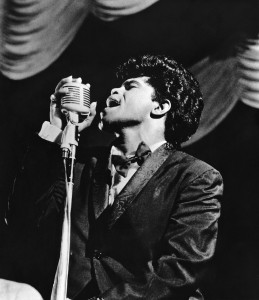 Richard’s manager at the time, Clint Brantley, at his nightclub. Brantley agreed to manage them after seeing the group audition for them. Brantley then sent them to a local radio station to record a demo session, where they performed their own composition “Please, Please, Please”, which was inspired when Little Richard wrote the words of the title on a napkin and Brown was determined to make a song out of it. The Famous Flames eventually signed with King Records’ Federal subsidiary and issued a re-recorded version of “Please, Please, Please” that March. The song became the group’s first R&B hit, selling over a million copies. None of their follow-ups produced similar success. By 1957, Brown had replaced Clint Brantley as manager and hired Ben Bart, chief of the Universal Attractions Agency. That year, the original Flames broke up after Bart changed the name of the group to “James Brown and The Famous Flames”. In October 1958, Brown released the ballad, “Try Me”, which hit number-one on the R&B chart in the beginning of 1959, becoming the first of seventeen chart-topping R&B hits. Shortly afterwards, Brown recruited his first band, led by J. C. Davis and reunited with Bobby Byrd, who joined a revived Famous Flames lineup that included Eugene “Baby” Lloyd Stallworth and Bobby Bennett, with Johnny Terry sometimes coming in as the “fifth Flame”. Brown,The Flames, and his entire band debuted at theApollo Theater on April 24, 1959, opening for Little Willie John.[24][35] Federal Records issued two albums credited to Brown and the Famous Flames. By 1960, Brown began multi-tasking in the recording studio involving himself, the Famous Flames and his band, sometimes named the James Brown Orchestra or the James Brown Band. That year, the band recorded the top ten R&B hit, “(Do the) Mashed Potatoes” on Dade Records, owned by Henry Stone, under the pseudonym “Nat Kendrick & The Swans”, due to label issues. As a result of its success, King president Syd Nathan shifted Brown’s contract from Federal to King. While under King, Brown, under the Famous Flames lineup, released the album, Think! and the following year, released two albums with the James Brown Band earning second billing. With the Famous Flames, Brown sung lead on several more hits including “I’ll Go Crazy” and “Think”, songs that hinted at his emerging style.
Richard’s manager at the time, Clint Brantley, at his nightclub. Brantley agreed to manage them after seeing the group audition for them. Brantley then sent them to a local radio station to record a demo session, where they performed their own composition “Please, Please, Please”, which was inspired when Little Richard wrote the words of the title on a napkin and Brown was determined to make a song out of it. The Famous Flames eventually signed with King Records’ Federal subsidiary and issued a re-recorded version of “Please, Please, Please” that March. The song became the group’s first R&B hit, selling over a million copies. None of their follow-ups produced similar success. By 1957, Brown had replaced Clint Brantley as manager and hired Ben Bart, chief of the Universal Attractions Agency. That year, the original Flames broke up after Bart changed the name of the group to “James Brown and The Famous Flames”. In October 1958, Brown released the ballad, “Try Me”, which hit number-one on the R&B chart in the beginning of 1959, becoming the first of seventeen chart-topping R&B hits. Shortly afterwards, Brown recruited his first band, led by J. C. Davis and reunited with Bobby Byrd, who joined a revived Famous Flames lineup that included Eugene “Baby” Lloyd Stallworth and Bobby Bennett, with Johnny Terry sometimes coming in as the “fifth Flame”. Brown,The Flames, and his entire band debuted at theApollo Theater on April 24, 1959, opening for Little Willie John.[24][35] Federal Records issued two albums credited to Brown and the Famous Flames. By 1960, Brown began multi-tasking in the recording studio involving himself, the Famous Flames and his band, sometimes named the James Brown Orchestra or the James Brown Band. That year, the band recorded the top ten R&B hit, “(Do the) Mashed Potatoes” on Dade Records, owned by Henry Stone, under the pseudonym “Nat Kendrick & The Swans”, due to label issues. As a result of its success, King president Syd Nathan shifted Brown’s contract from Federal to King. While under King, Brown, under the Famous Flames lineup, released the album, Think! and the following year, released two albums with the James Brown Band earning second billing. With the Famous Flames, Brown sung lead on several more hits including “I’ll Go Crazy” and “Think”, songs that hinted at his emerging style.
Mr. Dynamite
By 1962, Brown scored a hit with his band with their cover of the instrumental, “Night Train”, becoming not only a top five R&B single but also Brown’s first top 40 entry on the Billboard Hot 100. That same year, the ballads, “Lost Someone” and “Baby You’re Right”, the latter a Joe Tex composition, added to his repertoire and increased his reputation with R&B audiences. On October 24, 1962, Brown financed a live recording of a performance at the Apollo and convinced Syd Nathan to release the album, despite Nathan’s beliefs that no one bought live albums due to the fact that Brown’s singles were already bought and that live albums were usually bad sellers. Live at the Apollo was released the following June and became an immediate hit, eventually reaching number two on the Top LPs chart and selling over a million copies, staying on the charts for 14 months. In 1963, Brown scored his first top 20 pop hit with his rendition of the standard, “Prisoner of Love”. He also launched his first label, Try Me Records, which included recordings by the likes of Tammy Montgomery, Johnny & Bill (Famous Flames associates Johnny Terry and Bill Hollings) and the Poets, which was another name used for Brown’s backing band.

Brown (middle) & The Famous Flames (far left to right, Bobby Bennett, Lloyd Stallworth, andBobby Byrd), performing live at the Apollo Theaterin New York City, 1964
In 1964, seeking bigger commercial success, Brown and Bobby Byrd formed the production company, Fair Deal, linking the operation to the Mercury imprint, Smash Records. King Records, however, fought against this and was granted an injunction preventing Brown from releasing any recordings for the label. Prior to the injunction, Brown had released three vocal singles, including the blues-oriented hit, “Out of Sight”, which further indicated the direction his music was going to take. Touring throughout the year, Brown and the Famous Flames grabbed more national attention after giving a high-octane performance on the live concert film, The T.A.M.I. Show. The Flames’ polished choreography and timing as well as Brown’s energetic dance moves and high-octane vocals upstaged the show from proposed closing act, the Rolling Stones. With a new deal with King, Brown released his composition, “Papa’s Got a Brand New Bag”, which became his first top ten pop hit and won Brown his first Grammy Award. Later in 1965, Brown issued “I Got You”, which became his second single in a row to reach number-one on the R&B chart and top ten on the pop chart. Brown followed that up with the ballad, “It’s a Man’s Man’s Man’s World” which confirmed his stance as a top-ranking performer, especially with R&B audiences from that point on.
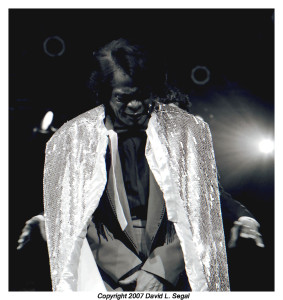 Soul Brother No. 1
Soul Brother No. 1
By 1967, Brown’s emerging sound had begun to be defined as funk music. That year, he released what some critics cited as the first true funk song, “Cold Sweat”, which hit number-one on the R&B chart and became one of his first recordings to contain a drum break and also the first that featured a harmony that was reduced to a single chord. The instrumental arrangements on tracks such as “Give It Up Or Turnit A Loose” and “Licking Stick-Licking Stick” (both recorded in 1968) and “Funky Drummer” (recorded in 1969) featured a more developed version of Brown’s mid-1960s style, with the horn section, guitars, bass and drums meshed together in intricate rhythmic patterns based on multiple interlocking riffs. Changes in Brown’s style that started with “Cold Sweat” also established the musical foundation for Brown’s later hits, such as “I Got the Feelin'” (1968) and “Mother Popcorn” (1969). By this time Brown’s vocals frequently took the form of a kind of rhythmic declamation, not quite sung but not quite spoken, that only intermittently featured traces of pitch or melody. This would become a major influence on the techniques of rapping, which would come to maturity along with hip hop music in the coming decades. Brown’s style of funk in the late 1960s was based on interlocking syncopated parts: funky bass lines, drum patterns, and iconic guitar riffs. The main guitar ostinatos for “Ain’t It Funky” and “Give It Up or Turn It Loose” (both 1969), are examples of Brown’s refinement of New Orleans funk; irresistibly danceable riffs, stripped down to their rhythmic essence. On both recordings the tonal structure is bare bones. The pattern of attack-points is the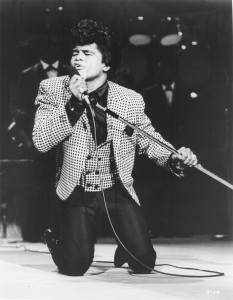 emphasis, not the pattern of pitches. It’s as if the guitar is an African drum, or idiophone. Alexander Stewart states that this popular feel was passed along from “New Orleans—through James Brown’s music, to the popular music of the 1970s.” Those same tracks were later resurrected by countless hip-hop musicians from the 1970s onward. As a result, James Brown remains to this day the world’s mostsampled recording artist, with “Funky Drummer” itself becoming the most sampled individual piece of music. “Bring it Up” has an Afro-Cuban guajeo-like structure. In fact, on a 1976 version, Cuban bongos are used. All three of these guitar riffs are based on an onbeat/offbeat structure. Stewart states: “This model, it should be noted, is different from a time line(such as clave and tresillo) in that it is not an exact pattern, but more of a loose organizing principle.” It was around this time as the musician’s popularity increased that he acquired the nickname, “Soul Brother No. 1”, after failing to win the title “King of Soul” from Solomon Burke during a Chicago gig two years prior. Brown’s recordings during this period influenced musicians across the industry, most notably groups such as Sly and the Family Stone, Funkadelic, Charles Wright & the Watts 103rd Street Rhythm Band, Booker T. & the M.G.’s as well as vocalists such as Edwin Starr, David Ruffin andDennis Edwards from The Temptations, and Michael Jackson, who, throughout his career, cited Brown as his ultimate idol. Brown’s band during this period employed musicians and arrangers who had come up through the jazz tradition. He was noted for his ability as a bandleader and songwriter to blend the simplicity and drive of R&B with the rhythmic complexity and precision of jazz. Trumpeter Lewis Hamlin and saxophonist/keyboardist Alfred “Pee Wee” Ellis (the successor to previous bandleader Nat Jones) led the band. Guitarist Jimmy Nolen provided percussive, deceptively simple riffs for each song, and Maceo Parker’s prominent saxophone solos provided a focal point for many performances. Other members of Brown’s band included stalwart Famous Flames singer and sideman Bobby Byrd, drummers John “Jabo” Starks, Clyde Stubblefield and Melvin Parker, saxophonist St. Clair Pinckney, trombonist Fred Wesley, guitarist Alphonso “Country” Kellum and bassist Bernard Odum. In addition to a torrent of singles and studio albums, Brown’s output during this period included two more successful live albums, Live at the Garden (1967) and Live at the Apollo, Volume II (1968), and a 1968
emphasis, not the pattern of pitches. It’s as if the guitar is an African drum, or idiophone. Alexander Stewart states that this popular feel was passed along from “New Orleans—through James Brown’s music, to the popular music of the 1970s.” Those same tracks were later resurrected by countless hip-hop musicians from the 1970s onward. As a result, James Brown remains to this day the world’s mostsampled recording artist, with “Funky Drummer” itself becoming the most sampled individual piece of music. “Bring it Up” has an Afro-Cuban guajeo-like structure. In fact, on a 1976 version, Cuban bongos are used. All three of these guitar riffs are based on an onbeat/offbeat structure. Stewart states: “This model, it should be noted, is different from a time line(such as clave and tresillo) in that it is not an exact pattern, but more of a loose organizing principle.” It was around this time as the musician’s popularity increased that he acquired the nickname, “Soul Brother No. 1”, after failing to win the title “King of Soul” from Solomon Burke during a Chicago gig two years prior. Brown’s recordings during this period influenced musicians across the industry, most notably groups such as Sly and the Family Stone, Funkadelic, Charles Wright & the Watts 103rd Street Rhythm Band, Booker T. & the M.G.’s as well as vocalists such as Edwin Starr, David Ruffin andDennis Edwards from The Temptations, and Michael Jackson, who, throughout his career, cited Brown as his ultimate idol. Brown’s band during this period employed musicians and arrangers who had come up through the jazz tradition. He was noted for his ability as a bandleader and songwriter to blend the simplicity and drive of R&B with the rhythmic complexity and precision of jazz. Trumpeter Lewis Hamlin and saxophonist/keyboardist Alfred “Pee Wee” Ellis (the successor to previous bandleader Nat Jones) led the band. Guitarist Jimmy Nolen provided percussive, deceptively simple riffs for each song, and Maceo Parker’s prominent saxophone solos provided a focal point for many performances. Other members of Brown’s band included stalwart Famous Flames singer and sideman Bobby Byrd, drummers John “Jabo” Starks, Clyde Stubblefield and Melvin Parker, saxophonist St. Clair Pinckney, trombonist Fred Wesley, guitarist Alphonso “Country” Kellum and bassist Bernard Odum. In addition to a torrent of singles and studio albums, Brown’s output during this period included two more successful live albums, Live at the Garden (1967) and Live at the Apollo, Volume II (1968), and a 1968 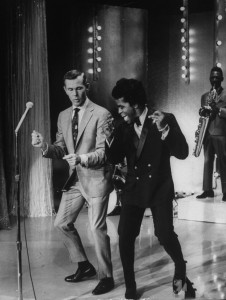 television special, James Brown: Man to Man. His music empire expanded along with his influence on the music scene. As Brown’s music empire grew, his desire for financial and artistic independence grew as well. Brown bought radio stations during the late 1960s, including WRDW in his native Augusta, where he shined shoes as a boy. In November 1967, James Brown purchased radio station WGYW in Knoxville, Tennessee for a reported $75,000, according to the January 20, 1968 Record World magazine. The call letters were changed to WJBE reflecting his initials. WJBE began on January 15, 1968 and broadcast a Rhythm & Blues format. The station slogan was “WJBE 1430 Raw Soul”. Brown also bought WEBB in Baltimore in 1970. Brown branched out to make several recordings with musicians outside his own band. In an attempt to appeal to the older, more affluent, and predominantly white adult contemporary audience, Brown recorded Gettin’ Down To It (1969) and Soul on Top(1970)–two albums consisting mostly of romantic ballads, jazz standards, and homologous reinterpretations of his earlier hits—with the Dee Felice Trio and the Louie Bellson Orchestra. In 1968, he recorded a number of funk-oriented tracks with The Dapps, a white Cincinnati band, including the hit “I Can’t Stand Myself”. He also released three albums of Christmas music with his own band.
television special, James Brown: Man to Man. His music empire expanded along with his influence on the music scene. As Brown’s music empire grew, his desire for financial and artistic independence grew as well. Brown bought radio stations during the late 1960s, including WRDW in his native Augusta, where he shined shoes as a boy. In November 1967, James Brown purchased radio station WGYW in Knoxville, Tennessee for a reported $75,000, according to the January 20, 1968 Record World magazine. The call letters were changed to WJBE reflecting his initials. WJBE began on January 15, 1968 and broadcast a Rhythm & Blues format. The station slogan was “WJBE 1430 Raw Soul”. Brown also bought WEBB in Baltimore in 1970. Brown branched out to make several recordings with musicians outside his own band. In an attempt to appeal to the older, more affluent, and predominantly white adult contemporary audience, Brown recorded Gettin’ Down To It (1969) and Soul on Top(1970)–two albums consisting mostly of romantic ballads, jazz standards, and homologous reinterpretations of his earlier hits—with the Dee Felice Trio and the Louie Bellson Orchestra. In 1968, he recorded a number of funk-oriented tracks with The Dapps, a white Cincinnati band, including the hit “I Can’t Stand Myself”. He also released three albums of Christmas music with his own band.
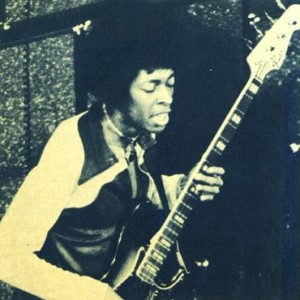 In March 1970, most of Brown’s mid-to-late 1960s road band walked out on him due to money disputes, a development augured by the prior disbandment of The Famous Flames in 1968. Brown and erstwhile Famous Flames singer Bobby Byrd (who elected to remain in the band during this tumultuous
In March 1970, most of Brown’s mid-to-late 1960s road band walked out on him due to money disputes, a development augured by the prior disbandment of The Famous Flames in 1968. Brown and erstwhile Famous Flames singer Bobby Byrd (who elected to remain in the band during this tumultuous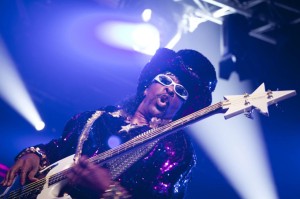 period) subsequently recruited several members of the Cincinnati-based The Pacemakers, which included Bootsy Collins and his brother Phelps “Catfish” Collins; augmented by the remaining members of the 1960s road band (including Fred Wesley, who rejoined Brown’s outfit in December 1970) and other newer musicians, they would form the nucleus of The J.B.’s, Brown’s new backing ensemble. Shortly following their first performance together, the band entered the studio to record the Brown-Byrd composition, “Get Up (I Feel Like Being a) Sex Machine”; the song and other contemporaneous singles would further concretize Brown’s influence in the nascent genre of funk music. This iteration of the J.B.’s dissolved after a March 1971 European tour (documented on the 1991 archival release Love Power Peace) due to additional money disputes and Bootsy Collins’ use of LSD; the Collins brothers would soon become integral members ofParliament-Funkadelic, while a new lineup of the J.B.’s coalesced around Wesley, St. Clair Pinckney, and drummer John Starks. In 1971, Brown began recording for Polydor Records which also took over distribution of Brown’s King Records catalog. Many of his sidemen and supporting players, including Andre Beeka, Fred Wesley & the J.B.’s, Bobby Byrd, Lyn Collins, Vicki Anderson and former rival Hank Ballard, released records on the People label, an imprint founded by Brown that was purchased by Polydor as part of Brown’s new contract. The recordings on the People label, almost all of which were produced by Brown himself, exemplified his “house style”. Songs such as “I Know You Got Soul” by Bobby Byrd, “Think” by Lyn Collins and “Doing It to Death” by Fred Wesley & the J.B.’s are considered as much a part of Brown’s recorded legacy as the recordings released under his own name. That year, he also began touring African countries and was received well by audiences there. During the 1972 presidential election, James Brown openly proclaimed his support of Richard Nixon for reelection of the presidency over Democratic candidate George McGovern. The decision led to a boycott of his performances and, according to Brown, cost him a big portion of his black audience. As a result Brown’s record sales and concerts in the United States reached a lull in 1973 as he failed to land a number-one R&B single that year. Brown relied more on touring outside the United States where he continued to perform for sold-out crowds in cities such as London, Paris and Lausanne. That year, Brown also faced problems with the IRS for failure to pay back taxes, charging he hadn’t paid upwards of $4.5 million, five years earlier, the IRS claimed he owed nearly $2 million.
period) subsequently recruited several members of the Cincinnati-based The Pacemakers, which included Bootsy Collins and his brother Phelps “Catfish” Collins; augmented by the remaining members of the 1960s road band (including Fred Wesley, who rejoined Brown’s outfit in December 1970) and other newer musicians, they would form the nucleus of The J.B.’s, Brown’s new backing ensemble. Shortly following their first performance together, the band entered the studio to record the Brown-Byrd composition, “Get Up (I Feel Like Being a) Sex Machine”; the song and other contemporaneous singles would further concretize Brown’s influence in the nascent genre of funk music. This iteration of the J.B.’s dissolved after a March 1971 European tour (documented on the 1991 archival release Love Power Peace) due to additional money disputes and Bootsy Collins’ use of LSD; the Collins brothers would soon become integral members ofParliament-Funkadelic, while a new lineup of the J.B.’s coalesced around Wesley, St. Clair Pinckney, and drummer John Starks. In 1971, Brown began recording for Polydor Records which also took over distribution of Brown’s King Records catalog. Many of his sidemen and supporting players, including Andre Beeka, Fred Wesley & the J.B.’s, Bobby Byrd, Lyn Collins, Vicki Anderson and former rival Hank Ballard, released records on the People label, an imprint founded by Brown that was purchased by Polydor as part of Brown’s new contract. The recordings on the People label, almost all of which were produced by Brown himself, exemplified his “house style”. Songs such as “I Know You Got Soul” by Bobby Byrd, “Think” by Lyn Collins and “Doing It to Death” by Fred Wesley & the J.B.’s are considered as much a part of Brown’s recorded legacy as the recordings released under his own name. That year, he also began touring African countries and was received well by audiences there. During the 1972 presidential election, James Brown openly proclaimed his support of Richard Nixon for reelection of the presidency over Democratic candidate George McGovern. The decision led to a boycott of his performances and, according to Brown, cost him a big portion of his black audience. As a result Brown’s record sales and concerts in the United States reached a lull in 1973 as he failed to land a number-one R&B single that year. Brown relied more on touring outside the United States where he continued to perform for sold-out crowds in cities such as London, Paris and Lausanne. That year, Brown also faced problems with the IRS for failure to pay back taxes, charging he hadn’t paid upwards of $4.5 million, five years earlier, the IRS claimed he owed nearly $2 million. 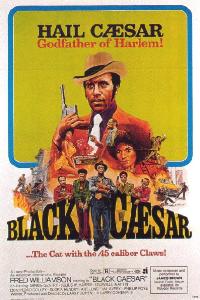 In 1973, Brown provided the score for the blaxploitation film Black Caesar. He also recorded another soundtrack for the film, Slaughter’s Big Rip-Off. Following the release of these
In 1973, Brown provided the score for the blaxploitation film Black Caesar. He also recorded another soundtrack for the film, Slaughter’s Big Rip-Off. Following the release of these 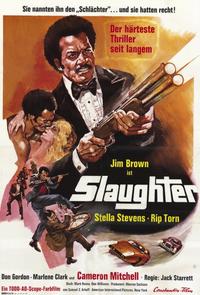 soundtracks, Brown acquired a self-styled nickname, “The Godfather of Soul”, which remains his most popular nickname. In 1974, he returned to the No. 1 spot on the R&B charts with “The Payback”, with the parent album reaching the same spot on the album charts; he would reach No. 1 two more times in 1974 including “My Thang” and “Papa Don’t Take No Mess”. Later that year, he returned to Africa and performed in Kinshasa as part of the buildup to The Rumble in the Jungle fight between Muhammad Ali and George Foreman. Admirers of Brown’s music, including Miles Davis and other jazz musicians, began to cite Brown as a major influence on their own styles. However, Brown, like others who were influenced by his music, also “borrowed” from other musicians. His 1976 single “Hot (I Need To Be Loved, Loved, Loved, Loved)” (R&B #31) used the main riff from “Fame” by David Bowie, not the other way around as was often believed. The riff was provided to “Fame” co-writers John Lennon and Bowie by guitarist Carlos Alomar, who had briefly been a member of Brown’s band in the late 1960s. Brown’s “Papa Don’t Take No Mess” would be his final single to reach the No. 1 spot on the R&B charts and his final Top 40 pop single of the 1970s, though Brown continued to occasionally have Top 10 R&B recordings. Among his top ten R&B hits during this latter period included “Funky President” and “Get Up Offa That Thing”, the latter song released in 1976 and aimed at musical rivals such as Barry White, The Ohio Players and K.C. and the Sunshine Band. Brown credited his then-second wife and two of their children as writers of the song to avoid concurrent tax problems with the IRS. Starting in October 1975, Brown produced, directed, and hosted Future Shock, an Atlanta-based television variety show which ran for three years.
soundtracks, Brown acquired a self-styled nickname, “The Godfather of Soul”, which remains his most popular nickname. In 1974, he returned to the No. 1 spot on the R&B charts with “The Payback”, with the parent album reaching the same spot on the album charts; he would reach No. 1 two more times in 1974 including “My Thang” and “Papa Don’t Take No Mess”. Later that year, he returned to Africa and performed in Kinshasa as part of the buildup to The Rumble in the Jungle fight between Muhammad Ali and George Foreman. Admirers of Brown’s music, including Miles Davis and other jazz musicians, began to cite Brown as a major influence on their own styles. However, Brown, like others who were influenced by his music, also “borrowed” from other musicians. His 1976 single “Hot (I Need To Be Loved, Loved, Loved, Loved)” (R&B #31) used the main riff from “Fame” by David Bowie, not the other way around as was often believed. The riff was provided to “Fame” co-writers John Lennon and Bowie by guitarist Carlos Alomar, who had briefly been a member of Brown’s band in the late 1960s. Brown’s “Papa Don’t Take No Mess” would be his final single to reach the No. 1 spot on the R&B charts and his final Top 40 pop single of the 1970s, though Brown continued to occasionally have Top 10 R&B recordings. Among his top ten R&B hits during this latter period included “Funky President” and “Get Up Offa That Thing”, the latter song released in 1976 and aimed at musical rivals such as Barry White, The Ohio Players and K.C. and the Sunshine Band. Brown credited his then-second wife and two of their children as writers of the song to avoid concurrent tax problems with the IRS. Starting in October 1975, Brown produced, directed, and hosted Future Shock, an Atlanta-based television variety show which ran for three years.
Decline and resurgence
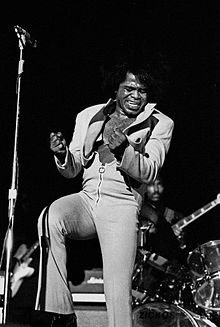
Although his records were mainstays of the vanguard New York underground disco scene exemplified by DJs such as David Mancuso and Francis Grasso from 1969 onwards, Brown did not consciously yield to the trend until 1975’s Sex Machine Today. By 1977, he was no longer a dominant force in R&B. After “Get Up Offa That Thing”, thirteen of Brown’s late 1970s recordings for Polydor, failed to reach the Top 10 of the R&B chart, with only “Bodyheat” in 1976 and the disco-oriented “It’s Too Funky in Here” in 1979 reaching the R&B Top 15 and the ballad “Kiss in ’77” reaching the Top 20. After 1976’s “Bodyheat”, he also failed to appear on the Billboard Hot 100. As a result, Brown’s concert attendance began dropping and reported disputes with the IRS caused Brown’s empire to collapse. In addition, Brown’s former band mates, including Fred Wesley, Maceo Parker and the Collins brothers, had found bigger success as members of George Clinton’s Parliament-Funkadelic collective. The emergence of disco also stopped Brown’s success on the R&B charts as its slicker commercial style had superseded his rawer funk productions. By the release of 1979’s The Original Disco Man, Brown was not providing much production or writing, leaving most of it to producer Brad Shapiro, resulting in the song “It’s Too Funky in Here” becoming Brown’s most successful single in this period. After two more albums failed to chart, Brown left Polydor in 1981. It was around this time that Brown changed the name of his band from the J.B.’s to the Soul Generals (or Soul G’s). This band’s name remained that way until his death. Despite a decline in record sales, Brown enjoyed something of a resurgence in this period starting with appearances in the feature films The Blues Brothers, Doctor Detroit and Rocky IV, as well as guest starring in the Miami Vice episode “Missing Hours” (1987). In 1984, Brown teamed with rap musician Afrika Bambaattaa on the song “Unity”. A year later he signed with Scotti Brothers Records and issued the moderately successful album, Gravity, in 1986. It included Brown’s final Top 10 pop hit, “Living in America”, marking his first Top 40 entry since 1974 and his first Top 10 pop entry since 1968. Produced and written by Dan Hartman, it was also featured prominently on the Rocky IV film and soundtrack. Brown performed the song in the film at Apollo Creed’s final fight, shot in the Ziegfeld Room at the MGM Grand in Las Vegas, and was credited in the film as “The Godfather of Soul.” 1986 also saw the publication of Brown’s autobiography, James Brown: The Godfather of Soul, co-written with Bruce Tucker. In 1987, Brown won the Grammy for Best Male R&B Vocal Performance for “Living in America”. In 1988, Brown worked with the production team Full Force on the new jack swing-influenced album I’m Real. It spawned his final two Top 10 R&B hits, “I’m Real” and “Static”, which peaked at No. 2 and No. 5, respectively, on the R&B charts. Meanwhile, the drum break from the second version of the original 1969 hit “Give It Up Or Turnit A Loose” (the recording included on the compilation album In the Jungle Groove) became so popular at hip hop dance parties (especially for breakdance) during the late 1970s and early 1980s that hip hop founding father Kurtis Blow called the song “the national anthem of hip hop”. After his stint in prison during the late 1980s, Brown met Larry Fridie and Thomas Hart who produced the first Biopic, James Brown, The Man, The Message, The Music. The Story of James Brown. James Brown returned with the album Love Over-Due in 1991. It included the single “(So Tired of Standing Still We Got to) Move On”, which peaked at No. 48 on the R&B chart. His former record label Polydor also released the four-CD box set, Star Time, spanning Brown’s career to date. Brown’s release from prison also prompted his former record labels to reissue his albums on CD, featuring additional tracks and commentary by music critics and historians. That same year, Brown appeared on rapper MC Hammer’s video for “Too Legit to Quit”. Hammer had been noted, alongside Big Daddy Kane, for bringing Brown’s unique stage shows and their own energetic dance moves to the hip-hop generation, with both Hammer and Kane listing Brown as their idol. Both musicians also sampled Brown’s work, with Hammer having sampled the rhythms from “Super Bad” for his song, “Here Comes the Hammer”, from his best-selling album, Please Hammer, Don’t Hurt ‘Em. Before the year was over, Brown, who had immediately returned to work with his band following his release, organized a pay-per-view concert following a show at Los Angeles’ Wiltern Theatre, that was well received.
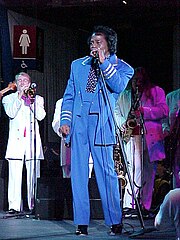
Brown continued making recordings. In 1993, his album Universal James was released. It included his final Billboard charting single, “Can’t Get Any Harder”, which peaked at No. 76 on the US R&B chart and reached No. 59 on the UK chart. Its brief charting in the UK was probably due to the success of a remixed version of “I Feel Good” featuringDakeyne. Brown also released the singles, “How Long” and “Georgia-Lina”, which failed to chart. In 1995 Brown returned to the Apollo and recorded Live at the Apollo 1995. It included a studio track titled “Respect Me”, which was released as a single; again it failed to chart. Brown’s final studio albums, I’m Back and The Next Step, were released in 1998 and 2002 respectively. I’m Back featured the song “Funk on Ah Roll”, which peaked at No. 40 in the UK but did not chart in his native US. The Next Step included Brown’s final single, “Killing Is Out, School Is In”. Both albums were produced by Derrick Monk. Brown’s concert success, however, remained unabated and Brown kept up with a grueling schedule throughout the remainder of his life, living up to his previous nickname, “The Hardest Working Man in Show Business”, in spite of his advanced age. In 2003, Brown participated in the PBS American Masters television documentary James Brown: Soul Survivor, which was directed by Jeremy Marre. Brown celebrated his status as an icon by appearing in a variety of entertainment and sports events, including an appearance on the WCW pay-per-view event, SuperBrawl X, where he danced alongside wrestler 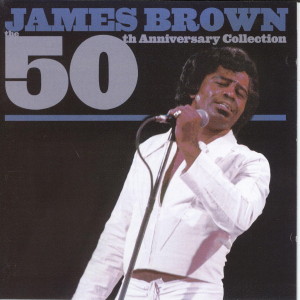 Ernest “The Cat” Miller, who based his character on Brown, during his in-ring skit with The Maestro. Brown was then featured in Tony Scott’s short film, Beat the Devil, in 2001. Brown was featured alongside Clive Owen, Gary Oldman, Danny Trejo and Marilyn Manson. Brown also made a cameo appearance in the 2002 Jackie Chan film The Tuxedo, in which Chan was required to finish Brown’s act after Brown was accidentally knocked out by Chan. In 2002, Brown appeared in Undercover Brother, playing himself. The beginning of 2005 saw the publication of Brown’s second book, I Feel Good: A Memoir of a Life of Soul, written with Marc Eliot. In February and March he participated in recording sessions for an intended studio album with Fred Wesley, Pee Wee Ellis, and other longtime collaborators. Though he lost interest in the album, which remains unreleased, a track from the sessions, “Gut Bucket”, appeared on a compilation CD included with the August 2006 issue of MOJO. He appeared at Edinburgh 50,000 – The Final Push, the final Live 8 concert on July 6, 2005, where he performed a duet with British pop star Will Young on “Papa’s Got A Brand New Bag”. He also performed a duet with another British pop star, Joss Stone, a week earlier on the United Kingdom chat show Friday Night with Jonathan Ross. Before his death, Brown was scheduled to perform a duet with singer Annie Lennox on the song “Vengeance” for her new album Venus, which was released in 2007. In 2006, Brown continued his “Seven Decades of Funk World Tour”, his last concert tour where he performed all over the world. His final U.S. performances were in San Francisco on August 20, 2006, as headliner at the Festival of the Golden Gate (Foggfest) on the Great Meadow at Fort Mason. The following day, August 21, he performed at Humboldt State University in Arcata, CA, at a small theatre (800 seats) on campus. His last shows were greeted with positive reviews, and one of his final concert appearances at the Irish Oxegen festival in Punchestown in 2006 was performed for a record crowd of 80,000 people. He played a full concert as part of the BBC’s Electric Proms on October 27, 2006, at The Roundhouse, supported by The Zutons, with special appearances from Max Beasley and The Sugababes. Brown’s last televised appearance was at his induction into the UK Music Hall of Fame in November 2006, before his death the following month. If you never had a chance to see James Brown live, just image wrapping Michael Jackson, Prince and this new kid you may have heard of by the name of Bruno Mars. The Godfather of Soul’s impact reached far beyond the borders of the US. He was so influential to every music segment in the world. This is evident by watching two legends from to different worlds, come together and combine musical greatness into one beautiful sound.
Ernest “The Cat” Miller, who based his character on Brown, during his in-ring skit with The Maestro. Brown was then featured in Tony Scott’s short film, Beat the Devil, in 2001. Brown was featured alongside Clive Owen, Gary Oldman, Danny Trejo and Marilyn Manson. Brown also made a cameo appearance in the 2002 Jackie Chan film The Tuxedo, in which Chan was required to finish Brown’s act after Brown was accidentally knocked out by Chan. In 2002, Brown appeared in Undercover Brother, playing himself. The beginning of 2005 saw the publication of Brown’s second book, I Feel Good: A Memoir of a Life of Soul, written with Marc Eliot. In February and March he participated in recording sessions for an intended studio album with Fred Wesley, Pee Wee Ellis, and other longtime collaborators. Though he lost interest in the album, which remains unreleased, a track from the sessions, “Gut Bucket”, appeared on a compilation CD included with the August 2006 issue of MOJO. He appeared at Edinburgh 50,000 – The Final Push, the final Live 8 concert on July 6, 2005, where he performed a duet with British pop star Will Young on “Papa’s Got A Brand New Bag”. He also performed a duet with another British pop star, Joss Stone, a week earlier on the United Kingdom chat show Friday Night with Jonathan Ross. Before his death, Brown was scheduled to perform a duet with singer Annie Lennox on the song “Vengeance” for her new album Venus, which was released in 2007. In 2006, Brown continued his “Seven Decades of Funk World Tour”, his last concert tour where he performed all over the world. His final U.S. performances were in San Francisco on August 20, 2006, as headliner at the Festival of the Golden Gate (Foggfest) on the Great Meadow at Fort Mason. The following day, August 21, he performed at Humboldt State University in Arcata, CA, at a small theatre (800 seats) on campus. His last shows were greeted with positive reviews, and one of his final concert appearances at the Irish Oxegen festival in Punchestown in 2006 was performed for a record crowd of 80,000 people. He played a full concert as part of the BBC’s Electric Proms on October 27, 2006, at The Roundhouse, supported by The Zutons, with special appearances from Max Beasley and The Sugababes. Brown’s last televised appearance was at his induction into the UK Music Hall of Fame in November 2006, before his death the following month. If you never had a chance to see James Brown live, just image wrapping Michael Jackson, Prince and this new kid you may have heard of by the name of Bruno Mars. The Godfather of Soul’s impact reached far beyond the borders of the US. He was so influential to every music segment in the world. This is evident by watching two legends from to different worlds, come together and combine musical greatness into one beautiful sound.


